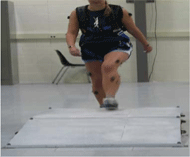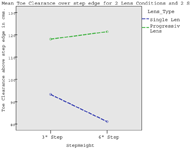MEASURING THE EFFECTS OF MULTIFOCAL LENS GLASSES ON GAIT USING BIOMECHANICAL SENSORS
Dennis B. Tomashek, M.S., Kurt E. Beschorner, Ph.D., Autumn Milanowski, B.S., Roger O. Smith, Ph.D
Rehabilitation Research Design & Disability Center, University of Wisconsin-Milwaukee Department of Industrial & Manufacturing Engineering, University of Wisconsin-Milwaukee
ABSTRACT
This study used motion capture analysis and force plates to measure the performance on a stepup/stepdown walking task while wearing either clear non-prescription glasses or progressive lens glasses with a +2.75 diopter lower add region.
Previous studies have examined the effects of multifocal lens glasses (MfLs)-which can include lined bifocals and unlined progressive lenses-on stepping, but always from a stationary beginning position. This study incorporated the task within a loop of walking tasks, and included an approach of approximately 20’ for the ramp/step task to allow for a more natural gait. The initial results (n=5) show significant differences in toe clearance above the platform edge when stepping up and increased normal force when stepping down off of the platform when wearing progressive lens glasses. This has important implications for safe walking in the main population of progressive and bifocal glass wearers; those over the age of 65 who are already susceptible to a higher risk of falls due to natural aging processes.
BACKGROUND
Vision has recently received more attention as an important factor leading to an increased risk rate of falling (Marigold & Patla, 2008). Distorted vision has been linked to changes in gait length, width, variability, all of which are associated with falling (S. Lord, Smith, & Menant, 2010); (Weedersteyn, Nienhuis, & Duysens, 2005). Presbyopia is the naturally occurring form of myopia caused by the crystalline lens of the eye no longer being able to accommodate for near vision tasks due to aging (AOA.org, 2006-2009). Myopia in itself does not affect gait, rather it is the commonly prescribed solution that causes the problem. Multifocal lens glasses (MfLs), including lined bifocals and unlined progressive lenses, contain an upper region for distance viewing, and a lower “add” region for near viewing. While this is convenient, it also causes blurred vision in the lower visual field, which is important for safe ambulation (Patla, 1998). (S. R. Lord, Dayhew, J. & Howland, A., 2002) established MfLs as a potent factor in increased fall rates due to impaired depth perception and distant edge contrast sensitivity. These findings were reinforced in 2010 (Haran et al., 2010), showing an 8% increase in falls for older adults wearing MfLs.
Researchers have recently examined the effects of MfLs on the kinematics of stepping up onto a platform (Elliott & Chapman, 2009; Johnson, Buckley, Scally, & Elliott, 2008), and stepping down from a raised platform (Timmis, Johnson, Elliot, & Buckley, 2010). The authors of these studies compared the single lens (distance) performance to that of wearing MfLs, and found significant differences. However, all of these studies had participants start from a stationary position. Increased toe clearance is an indicator of a more cautious stepping pattern, potentially caused by the uncertainty of the actual step height caused by the impaired depth perception inherent with use of MfLs. The same effect accounts for the increase in normal force when stepping down, as the wearer is unsure of the actual distance to the ground.
THE DGI-M2 PROJECT
This study is part of a project to modify the Dynamic Gait Index (DGI) to include activities that are more sensitive to changes in gait caused by wearing MfLs. For a previous study, two tasks were added (a long, diagonal step- over obstacle and a step-up/step-down platform) to the original 8 tasks of the original DGI (Shumway-Cook & Woollacott, 1995). The scoring for the modified version of the DGI (DGI-m) was also increased to a 6 point scale, as the DGI was not found to be sensitive enough for younger novice MfL wearing adults in a previous study (Brayton, Smith & Tomashek, NP). The original DGI and the DGI- m are both designed to be rated by a trained observer. The researchers hypothesized that the use of objective measurement tools, such as motion capture and force plates would produce more consistent results. To accomplish this, the 10th task of the DGI-m (ascending and descending stairs) was changed to a ramp/step task (see below for description). Participants were outfitted with a set of 36 reflective markers on the lower limbs, foot and heel, torso, and head for the Motion Analysis Corporation 14 camera Raptor® system. Force plates (AMTI) were placed immediately before and after the ramp/step apparatus, and data was collected for the step down from the ramp/step.
The DGI-m2 Ramp/Step
 Figure 1. Image of the 6” and 3” ramp/steps created for the DGI-m2. d
Figure 1. Image of the 6” and 3” ramp/steps created for the DGI-m2. dThe ramp/step apparatus consists of two constructions, each of which has a ramp connected to a step. One step/ramp has a 3” step with a ramp pitched at 1” rise per foot of run, and the second step/ramp has a 6” step with a ramp pitched at 2” rise per foot of run. A total of 5 ramp/step conditions were tested: 1) level walking; 2) step up/ramp down (3”); 3) ramp up/step down (3”); 4) step up/ramp down (6”) and 5) ramp up/step down (6”). Participants were harnessed for safety during this task, and motion capture and force plate data was gathered at this time. Subjects performed a standard DGI-m task between each ramp/step task. The tasks were performed in a loop, with a 20’ straight walking approach before the ramp/step included to allow for a more natural walking pattern. Participants wore clear, non-prescription glasses for half of the trials, and a pair of non-lined progressive lens glasses that were clear on the top with an add region of +2.75 diopters in the bottom. The order of glasses was randomized. A total of 3 of each of the ramp/step conditions, and 6 normal walking trials were performed for each glasses condition. The trial order was randomized within each glasses condition.
Hypotheses
The authors hypothesized that:
- Kinematic variables, including toe clearance and hip, knee, and ankle angle would increase when wearing progressive lens glasses compared to clear glasses.
- The effects of the progressive lens glasses on the kinematic variables would be more pronounced for the 6” ramp/step compared to the 3” ramp/step.
- Hip, knee, and ankle flexion would correlate with toe clearance when stepping up.
- Normal force when stepping down would increase when wearing progressive lens glasses compared to clear glasses.
METHODS
Participants
 Figure 2. Participant negotiating DGI-m2 ramp/step. Participant is outfitted with safety harness, wireless EMG detectors, and reflective markers for Motion capture analysis. d
Figure 2. Participant negotiating DGI-m2 ramp/step. Participant is outfitted with safety harness, wireless EMG detectors, and reflective markers for Motion capture analysis. d20 young (18-25 years old) participants were recruited from the UWM campus. Participants were required to have normal or corrected to normal (at least 20/30) vision, but could not use corrective eyeglasses, only contact lenses. This protocol was reviewed and approved by the University of Wisconsin- Milwaukee Institutional Review Board. Data from the first 5 participants is presented here.
Data Analysis
A MANOVA was employed for the dependent kinematic variables, including toe clearance over the platform edge when stepping up, knee angle hip angle, and ankle angle. A separate ANOVA used normal force when stepping down from the platform as the dependent variable. Independent variables for all analyses included the lens condition and ramp/step height. The participant was used as a random factor. Correlations were conducted between the toe clearance and hip, knee, and ankle flexion.
RESULTS
 Figure 3. Mean Toe clearance over the step edge when stepping up for two step heights (3” & 6”) and two Lens Conditions (Clear Vs. Progressives). d
Figure 3. Mean Toe clearance over the step edge when stepping up for two step heights (3” & 6”) and two Lens Conditions (Clear Vs. Progressives). dToe clearance was found to be significantly different between the lens conditions (F=21.921), but not step height or the interaction. Main effects were significant for Hip angle at toe clearance for lens conditions (F=12.16, p=.001) and step height (F=14.33, p=.000) but not the interaction. Knee and ankle angle were significant for Step Height, but not for Lens Condition. Normal Force was found to be significantly different for Lens Condition (F=41.57, p=.006), Step Height (F=45.97, p<.000) and the Step Height by Lens Condition interaction (F=44.18, p=.05).
A significant correlation was found between toe clearance and hip angle (r=.41, p=.003), but not for toe clearance and ankle or knee angle.
CONCLUSION
The preliminary results of this study indicate that even in a young, healthy population, multifocal lens glasses have a significant effect on gait. The increased toe clearance when wearing progressive lenses may be an indication that the wearer is less sure of the actual step height and thus overcompensates by increasing their foot height. Importantly, toe clearance decreased over the 6” step when wearing clear glasses, as would be expected to minimize exertion. However, the toe clearance increase was even more pronounced for the 6” step when wearing the progressive lenses, a further indication that an adaptive stepping strategy was being employed. While this cautious style may seem to be a prudent means to avoid contacting the step edge, it may lead older adults into a precarious situation, with a longer single leg support stance and larger hip flexion. Older adults may already be suffering from impaired balance, and the use of multifocal lens glasses may exacerbate this, and lead to an increase in injurious or even fatal falls.
REFERENCES
Elliott, D. B., & Chapman, G. (2009). Adaptive gait changes due to spectacle magnification and dioptric blur in older people. Investigative Ophthalmology & Visual Science.
Haran, M., Cameron, I., Ivers, R., Simpson, J., Lee, B., Tanzer, M., et al. (2010). Effect on falls of providing single lens distance vision glasses to multifocal glasses wearers: VISIBLE randomised controlled trial. BMJ, 340, 1-7.
Johnson, L., Buckley, J. G., Scally, A., & Elliott, D. B. (2008). Use of single-vision eyeglasses improves stepping precision and safety when elderly habitual multifocal wearers negotiate a raised surface. Journal of American Geriatric Society, 56(1), 178-179.
Lord, S., Smith, S. T., & Menant, J. C. (2010). Vision and Falls in Older People: Risk Factors and Intervention Strategies. Clinical Geriatric Medicine, 26, 569-581.
Lord, S. R., Dayhew, J. & Howland, A. (2002). Multifocal Glasses impair edge-contrast sensitivity and depth perception and increase the risk of falls in older people. Journal of American Geriatric Society, 50 (11), 1760- 1766.
Marigold, D. S., & Patla, A. E. (2008). Visual information from the lower visual field is important for walking across multi-surface terrain. Journal of Experimental Brain Research, 188, 23-31.
Patla, A. E. (1998). How is Human Gait Controlled by Vision? Ecological Psychology, 10(3-4), 287- 302.
Shumway-Cook, A., & Woollacott, M. H. (1995). Motor Control: Theory and Practical Applications. Baltimore, MD: Wiiliams & Wilkins.
Timmis, M., Johnson, L., Elliot, D. B., & Buckley, J. G. (2010). use of Single-vision Distance Spectacles Improves Landing control during Step Descent in Well-Adapted Multifocal Lens- Wearers. Clinical and Epidemiologic Research, 51(8), 3903.
Weedersteyn, V., Nienhuis, B., & Duysens, J. (2005). Advancing age progressively affects obstacle avoidance skills in the elderly. Human Movement Sciences, 24, 865-880.